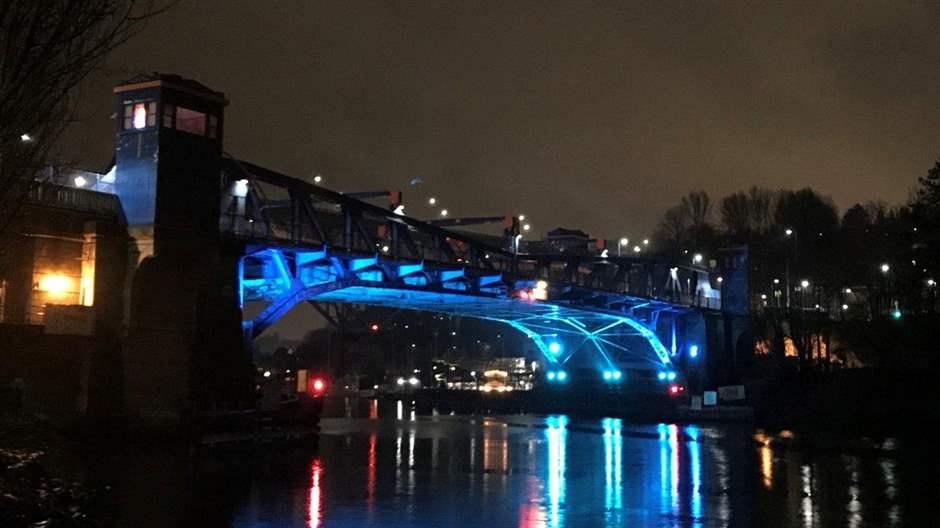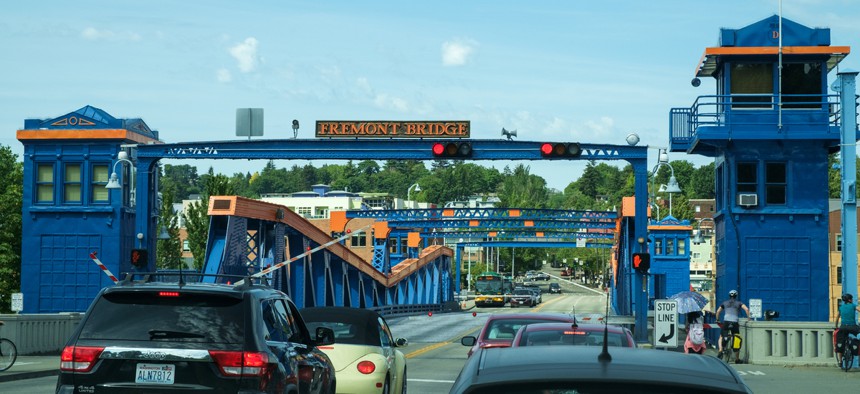Connecting state and local government leaders
A growing number of cities are hiring visual artists, musicians and performers to work on small- and large-scale projects that deal with transportation.
This story was originally published by Stateline, an initiative of The Pew Charitable Trusts.
Alan Nakagawa wanted to change the way people in Los Angeles perceive streets. So last year the artist created an interactive exhibit at a city bus shelter that housed a light green, cylindrical “perfume box.” Commuters could stick a hand inside and activate a spritz of scent.
Nakagawa developed the perfumes at a lab in Chinatown, and each represented something different: Into Town smelled like California sagebrush. Economic Development first smelled like lavender, but quickly changed to a coffee scent.
The idea, he said, was to try to evoke conversation and alter the sensory character of the street.
“We perceive through our senses. Changing an element of that sense may help how we perceive traffic,” Nakagawa said. “So I proposed we change the smell of traffic.”
For a year, Nakagawa created art projects in his role as the Los Angeles Transportation Department’s artist in residence.
While transportation agencies typically are stodgy behemoths, slow to adopt changes and filled with engineers who rely on data and scientific principles, some numbers-minded officials have been trying to think creatively.
So they’re turning to artists like Nakagawa to bring a fresh approach to projects and planning.

A growing number of cities are hiring visual artists, musicians and performers to work on small- and large-scale projects that deal with transportation, often in collaboration with arts and culture agencies.
Artists have designed colorful crosswalks, created displays about historical events at highway underpasses and put on performances to draw people to neighborhoods disrupted by light rail construction.
A handful of cities have gone even further, creating artist-in-residence programs hosted by transportation agencies, such as the one in Los Angeles. Next year, Washington will become the first state to do so.
“This isn’t like commissioning a piece of artwork,” said Barbara LaBoe, a spokeswoman at the Washington State Department of Transportation. “This is bringing in someone with an artistic sensibility and fresh eyes who can help us identify or develop new programs or improve the way we do something.”
Government officials envision that these programs will help generate creative solutions to long-term transportation problems, such as reducing congestion and making streets safer for drivers, pedestrians and bicyclists, and get communities more involved in the planning process, especially when residents and businesses will be affected by construction and road projects.
“We are trying to advocate for experimenting with new approaches. That can be a hard sell for organizations like DOTs,” said Ben Stone, director of arts and culture for Transportation for America. His nonprofit advocacy group is funding and administering the Washington state project through a $125,000 grant from ArtPlace America, a public-private partnership.
Washington state’s transportation department hopes to have its artist in residence on board by March, LaBoe said. The artist, who will get a $40,000 stipend and $25,000 for materials and related expenses through the grant, will spend a year embedded in the agency, rotating through 10 divisions during the first four months.
A committee of staffers from the transportation department, Transportation for America and ArtPlace America will interview and select the artist.
“The goal will be to investigate how decisions are made,” Stone said. “City and state DOTs control so much of the public space we interact with every day. Their [the officials’] job is thinking about how people move through it, but less on how infrastructure impacts people’s lives.”
Transportation officials need to consider, for example, how they communicate with the community about upcoming projects, the kind of barriers they put up around highways and the type of surroundings that people wait in at train or ferry stations, Stone said.
‘A Meeting of the Minds’
As Washington begins its program, officials there can look to cities that already have done it.
In Los Angeles, Nakagawa worked on about a dozen projects during his yearlong residency that ended last year at the transportation department. He was paid $20,000.
A local artist with a background in sound and music and visual arts, Nakagawa loved the gig and said it was important to be able to spend lots of time with the engineers, watching them in action.
“We want to look at government as a monolith, but it is people. If you get paid to do an artwork for a site, you’re only going to have interaction with a handful of them, or maybe just one,” he said. “If you’re an artist in residence, you meet hundreds of people. It was an amazing experience.”
Nakagawa held a workshop for the engineers in which a professional storyteller taught them how to humanize their presentations to the public and communicate stories people would be interested in, rather than use dull, technical PowerPoint slides.
“The engineers said they’re trained not to tell stories, to be objective. We were telling them to be subjective,” Nakagawa said. “It was an amazing moment — a meeting of the minds.”
Nakagawa also recorded oral histories of agency staff past and present and produced a series of podcasts about the history of transportation in Los Angeles, including memories from one of the first female engineers.
Many of Nakagawa’s projects used public art to heighten awareness of traffic fatalities. In one, he produced two zines, which are small self-published works of texts and images. Both focused on pedestrian safety and traffic in Los Angeles and were filled with stories, photos and artwork from photographers, visual artists and poets.
Nakagawa said the artist-in-residence program, in which the transportation department partnered with the Department of Cultural Affairs, was a way for government to put a fresh spin on its mission to end roadway deaths.
“LA DOT is trying to save lives,” he said. “They thought art could help soften the edge of the message and at the same time be fun and inclusive.”
Bridge Art
The Seattle Department of Transportation envisioned something different for its artist-in-residence program. It focuses on producing art and performances that explore the role of the city’s three historic ship canal bridges.
Artists are embedded, but do not live, in a tiny space in one of the 101-year-old drawbridge’s towers, where they can work on their project and experience the bridge firsthand. They are paid $10,000 for a four-month contract, which can be extended.
The program is run by the Office of Arts & Culture and the transportation department, which funds it through a city ordinance that requires that 1 percent of its construction budget be spent on art.
“Our program draws attention to these beautiful old bridges that bring a real sense of civic pride,” said Kristen Ramirez, the transportation department’s project manager and a former artist in residence at Seattle’s historic Fremont Bridge.

One artist in residence was a Native American writer who researched and wrote two historical essays about the bridge canal and how it impacted indigenous people in the region. Another was a musician-composer, who is composing a piece about the Fremont Bridge for eight string instruments that will debut in May at Seattle Town Hall, a historic performance venue.
The transportation department also hired an artist-in-residence team to create a lighting plan for the three bridges to “make them sparkle,” Ramirez said. So far, lights only have been installed on one of them — the Fremont Bridge — because of funding.
Offering artists space to work in the bridge towers helps them as well as the public, who can enjoy the work they produce, Ramirez said.
“We’re having an affordability crisis in Seattle. A lot of artists are leaving the city,” she said. “They can’t afford studio space, so this gives them a place to do their work.”
City Art Projects
While city artist-in-residence programs still are rare, a growing number of local governments are turning to artists for a range of projects that deal with transportation.
In Orange, New Jersey, artists and archaeologists worked on a project in 2016 that used oral history, murals and ethnography to tell the story of what it was like for African-American and Italian-American neighborhoods before an interstate highway cut through the center of town in the 1960s.
In Indianapolis, the city’s public transportation agency, arts council and other groups collaborated on a project last year called Moving Stories, which gathered tales from bus riders and shared them through images and quotes displayed in buses, as well as with interactive components on social media.
And in Oakland, the transportation department this summer rolled out “Paint the Town,” a beautification program that offered community artists supplies and gave them permission to paint temporary street murals at intersections and mid-block sections of streets.
The melding of art and transportation will only become more popular, said Seattle’s Ramirez.
“Bridging that gap between artists and engineers and people focused on transit can be very challenging,” she said. “But this is a burgeoning, emerging field, and it will bring more imagination, color and beauty to our communities.”

NEXT STORY: Two Electric Utilities Have Promised to Go 100% Carbon-Free



